What Do Potato Bugs Eat might be a silly question to ask, but it is important to know How to Get Rid of Potato Bugs!
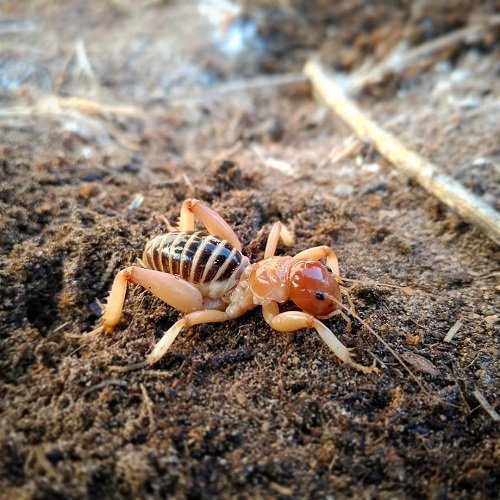
If you ever grew potatoes, then you must have seen the infestation of small, extraterrestrial insects crawling on the surface of leaves and near the roots. They can be quite a mess for your potato plants. They are known as potato bugs, and if you have questions hovering in your mind, like What do Potato Bugs Eat and How to Get Rid of Potato Bugs, then you are at the right place!
Learn How to Get Rid of Flies Naturally
What are Potato Bugs?
Potato bugs are classified into two different categories:
- The Jerusalem Cricket
- The Colorado Potato Beetle
The Jerusalem Crickets (Stenopelmatus fuscus) are discovered in the western and southern regions of the United States. They are a group of wingless insects having large, human-like jaws, heads, and an alien-like appearance. California potato bugs are large and can be 2-3 inches long. They also have amber-yellow heads, legs, and thoraxes with black-brown rinds on the abdomen.
Colorado Potato Beetles or potato beetles (Leptinotarsa decemlineata) belong to the nightshade or Solanaceae family and are endemic to the United States except for Alaska, California, Hawaii, and Nevada.
Potato bugs barely reach an inch and have black vertical stripes with hard yellow-orange outer wings. In the late 1800s, they start ruining potato, tomato, eggplant, and pepper fields throughout North America and Europe. Now, they can be seen throughout Asia.
Check out this article on natural pesticide recipes
Life Cycle of Potato Bugs
During winters, the adult Potato Bugs go 5-10 inches underground in field margins, gardens, potato fields, and windbreaks.
- In her adult life, each female potato bug lays up to 350 eggs, which last many weeks.
- The eggs start to hatch within 2-3 weeks, according to temperatures.
- During spring, adults feed for a short time. They begin to mate and lay clusters of 10-30 eggs on the undersides of the foliage.
- The larvae accumulate near the egg mass at a young stage and start to move across the plant as they munch the foliage.
- Larvae finish development within 10-12 days if average temperatures are between the mid-80s, whereas it can take a month if the average temperature is near 60°F or 15°C.
- The fourth instar larvae fall from the plant, excavate in the soil, and change into pupae.
- In central and southern Minnesota, there is a second generation. By midsummer, all stages of Colorado potato beetles, larvae, adults, and eggs can come to the potato field.
Check out the best ways to grow potatoes
What Do Potato Bugs Eat?
The diet of Potato Bugs includes other insects, roots of vegetable crops, and, of course, their favorite – potato tubers in the potato field. They don’t just harm potato crops but other vegetables like tomatoes, peppers, and eggplants from the Nightshade family. Female potato beetles lay eggs underneath the foliage, and the larvae survive by eating the leaves.
Potato bugs suck the juices from the foliage and stem of vegetables and fruits, which affects the growth of plants as the cricket leaves its toxic saliva behind, which harms plants. These bugs don’t have toxic glands; hence, they’re not vicious.
Although some gardeners do not consider potato bugs as pests in the garden and view them well for the soil, they aerate it when the cricket bugs bramble through the soil.
These bugs are also great for eating away dead roots and other decaying organic matter in your garden. In the lack of dead plant material, Jerusalem crickets begin to eat the fresh young plants in the garden.
Avoid these mistakes while propagating plants
Damage Caused by Potato Bugs 
Potato bugs greatly affect the potato yield as they munch on the plant leaves and can take over the whole plant if not controlled on time. Potatoes can resist 30 percent foliage loss without affecting the harvest. In contrast, Colorado potato beetles will end up feeding the whole of their foliage in a couple of weeks, ultimately killing the plant.
Also, the plant is sensitive and cannot take defoliation during the expansion of tubers, so potato bug infestation during this stage leads to limited or no harvest at all.
Discover the Use of Listerine to Repel Mosquitoes & Flies
How to Get Rid of Potato Bugs?
Potato Bugs can ruin the crop if they come in large numbers. They can be prevented by using chemical insecticides, trapping, baiting, disposal, and physically removing eggs or beetles from the plant. It is a good idea to keep an eye on outdoor objects such as lumber, woodpiles, and rocks that can become a hiding place for insects. Potato Bugs can also be controlled by crop rotation. We’ve got natural ways to remove potato bugs from your garden or yard.
Natural Ways
1. Keep the Yard Clean
You can get rid of these bugs by keeping the yard clean. There shouldn’t be any debris, dead grass, plant material, or scattered leaves. Clean these up every couple of days, and make sure you store the firewood about 2 inches from the ground.
2. Companion Planting
Companion plants can do your work for you when it comes to getting rid of potato bugs. There are many plants with a strong odor or special chemicals that are toxic to these bugs – like marigolds, basil, dill, and chrysanthemums.
By using these and keeping your yard clean, you can create a healthy environment that won’t be ruined by potato bugs. You can also introduce ladybugs and lacewings. These beneficial insects keep potato bugs away.
3. Say No to Mulch
Don’t use mulch. If you have mulched the garden with straw, wood chips, sawdust, or other organic materials, get rid of these. Potato bugs tend to lay their eggs in these, and they also make good hiding places for young bugs to nibble on the roots without you noticing.
If there’s a heavy infestation of potato bugs, you should remove all mulch from the garden and then start with a fresh new layer after a few weeks. This will break the cycle and reduce potato bugs significantly.
4. Seek Help from Nature
You can rely on the natural enemy of potato bugs, including birds from the shrike family and insects like spiny soldier bug that eats the eggs and larvae of the beetles.
Lady beetles and stink bugs will catch Colorado potato beetle eggs. The Beauveria bassiana fungus is effective for both adults and larvae. Even toads, ladybugs, soldier bugs, some birds, predatory stink bugs, ground beetles, tiny parasitic wasps, foraging chickens, and ducks can help you drive potato bugs away.
5. Pick Beetles From Plants
This method involves physically removing potato bugs from plants by hand. It is an effective method for small gardens or removing a few bugs from larger gardens. Simply pick the bugs off the plants and dispose of them in a bucket filled with soapy water. Crush or take off the yellow-orange eggs on the undersides of the foliage. Check the potatoes regularly, as new beetles can fly in the garden.
6. Crop Rotation
This method involves planting crops in a different garden area each year. This can help reduce the population of potato bugs by preventing them from building up in one area.
7. Floating Row Covers
It is a way to get rid of potato bugs where you have to cover the plants with a lightweight, floating-row cover that prevents these bugs from reaching the plants. The covers can be removed when the plants are in flower to allow for pollination.
8. Plant Early Maturing Varieties
To prevent damage from adults developing in midsummer, plant early maturing varieties. Examine the seed catalog for cultivars that mature in less than 80 days.
The crops on early maturing varieties are not as large and do not store well compared to the famous Russet Burbank potato.
Read all you need to know about growing sweet potatoes
How to Get Rid of Potato Bugs by Killing Them
1. Kill Potato Bugs with Diatomaceous Earth
This non-toxic way to eradicate potato bugs from the garden uses food-grade diatomaceous earth dust near your garden. DE is a natural powder from the fossilized remains of a kind of algae.
According to the National Pesticide Information Center (NPIC), diatomaceous earth destroys the insect’s exoskeleton. This makes them dry and die. Use food-grade DE as it is safe for the garden. Keep in mind that it is not useful in wet or damp climates.
Simply sprinkle the DE in potato bug-affected areas, repeat the process every few days, and reapply it after rain when the soil dries out.
Look at the Most Common Yellow Bugs on Plants
2. Use Soapy Water
A simple mixture of soap and water can go a long way in removing potato bugs from your plants. Just fill up a spray bottle with water and add 8-12 drops of dish soap to it. Shake the bottle to make a mixture, and then spray this soap water spray wherever you see potato bugs.
The solution breaks down the protective layer of potato bugs and dehydrates them. It’s a safe method and won’t do any harm to your plants. It’s a non-toxic one, too.
Learn how to make homemade insecticidal soap to kill pests
3. Use Neem Oil
Potato bugs can resist many commercial pesticides, but you can use Neem oil. It is safe for humans and has low toxicity to plants. Neem oil is effective in controlling Colorado Potato beetles and other bugs. Try this home remedy by making an insecticidal spray this way;
- Take a 500 ml spray bottle and fill 3/4 water.
- Add 1-2 tablespoons of neem oil and one tablespoon of Castile soap.
- Shake well to mix the ingredients.
- Spray on the areas where you spot the bugs.
- Reapply it every 2-4 days to settle the potato bug problem.
- Remember that potato bug larvae are seen on the undersides of the foliage, so don’t forget to spray those areas.
4. Use Sticky Traps
Make a trap by applying petroleum jelly on a small board and place it where you suspect the bugs; they will stick to the trap when walking on them.
5. Use Pesticides
Use azadirachtin or spinosad; these products are gentle on natural enemies. Azadirachtin (Neem) comes from the neem tree of Asia and Africa.
It works for a couple of days and needs a repeat application. Spinosad comes from the soil bacterium Saccharopolyspora Spinosa. It is useful for 10-14 days.
Read about Natural Pesticides for Gardens and Home
How to Get Rid of Potato Bugs with Chemical
Chemical treatments
There are a variety of chemical treatments, like insecticides, available that are designed to control potato bugs. It is important to follow the instructions on the product label carefully and to choose an insecticide that is safe for use on the plants in your garden.
- Pyrethroids: Pyrethroids are a class of synthetic insecticides that mimic the natural insecticide pyrethrin, which is found in chrysanthemum flowers. Pyrethroids are fast-acting and effective against many pests, including potato bugs.
- Organophosphates: Organophosphates are a class of insecticides that work by inhibiting the nervous system of pests. They are generally more toxic to humans and other mammals than pyrethroids and carbamates and are effective against potato bugs.
- Carbamates: Carbamates are a class of insecticides that work by inhibiting the nervous system of pests. They are generally less toxic to humans and other mammals than pyrethroids and are effective against potato bugs.
Are Potato Bugs Poisonous?
Potato bugs are not poisonous. However, these pests have toxin-rich saliva that can damage plants. These bugs can not be considered harmful to humans without any toxin glands. Sometimes though, a bite from a potato bug (Jerusalem Cricket) can be painful.
Check out our easy-to-make, homemade, natural pesticide
Do Potato Bugs Bite?
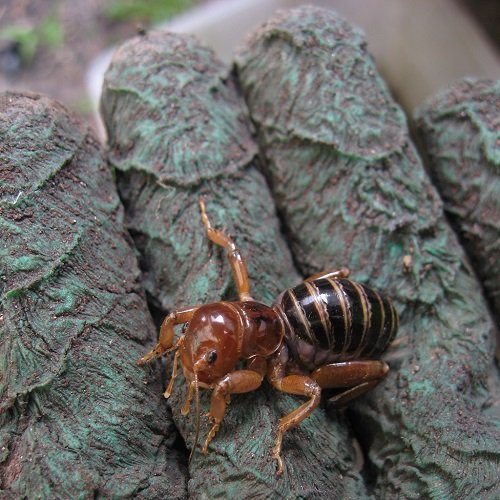
Potato Bug, Jerusalem Cricket, or Child of the Earth Bug bites are not poisonous, but they could inflict bad bites if they feel cornered or threatened.
If you spot a scary-looking bug with black and orange stripes in your home or garden, then you should remove it ASAP. Ensure safety to avoid getting bitten by the nasty bug’s strong jaws.
Tip: You should wear gloves while gardening to prevent getting bitten by these vast, ant-like creatures. Though the pain from the Jerusalem cricket is a non-toxic, painful bite, it usually lasts only a few minutes.
Learn about Making Insecticidal Soap at Home
What Does a Potato Bug Bite Look Like?
When a potato bug bites, it feels like a sharp, stinging feel. According to some people, the pain lasts for a few minutes. The bite gives a swelled or red appearance; sometimes, it looks like an itchy rash or a sore on the skin.
If you suffer from a bite, you’ll experience a painful allergic reaction that needs to be treated properly.
How to Treat a Potato Bug Bite?
To treat the bite, clean the affected area with warm water and soap to prevent germs near the wound. If there is itching and pain, apply diluted apple cider vinegar with a cotton ball 3-4 times a day till the itchiness is gone.
Do Potato Bugs Scream and Cry?
The potato bug does not have wings and moves around by hoping and not chirping like field crickets. But the sound that they make has been compared to a hissing or scratching sound.
If handled rudely, this insect can emit a foul smell. Despite the Spanish name – Nina de la Tierra, it does not cry like a child.
What Do Potato Bug Larvae Look Like?

- They hatch out of yellow to orange eggs about 1 millimeter long on the bottom of the leaves.
- They have two rows of dark spots on each side of their bodies.
- These bugs can be easily spotted by the two rows of dark spots on each side of their shells.
- It is easy to confuse them with the false potato beetles that have alternating white and black stripes on their shells.
- When young, larvae cluster near the egg mass but begin to move throughout the plant and eat all the leaves.
Tip: You can carefully remove or crush the yellow-orange eggs from the bottom of the leaves. Also, drop the larvae in a bucket filled with soap water.
Adults Appearance
- They are 3/8 inches long and oval in shape.
- The Colorado potato beetle has a yellow-orange prothorax (the part behind the head) and yellow-white wing coats with ten narrow black streaks.
- Females lay bunches of bright yellow-orange oval eggs on the undersides of the foliage.
Larvae Appearance
- Once the young larvae hatch first, they look brick red with blackheads.
- Adult larvae are pink to salmon-hued with blackheads.
- All larvae consist of two rows of dark spots on every side of the bodies.


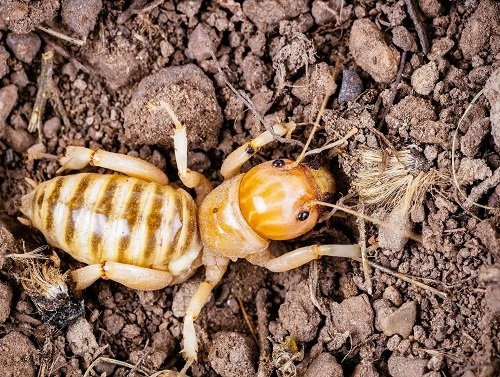
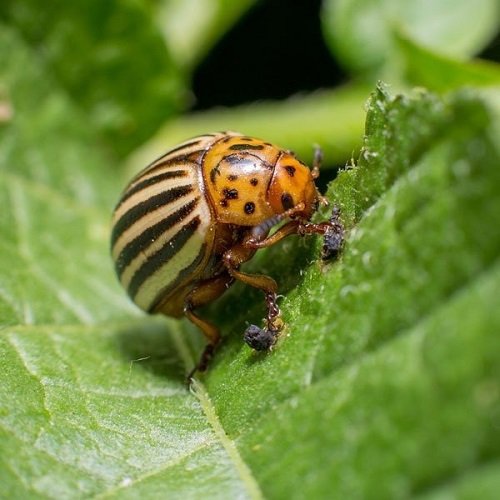
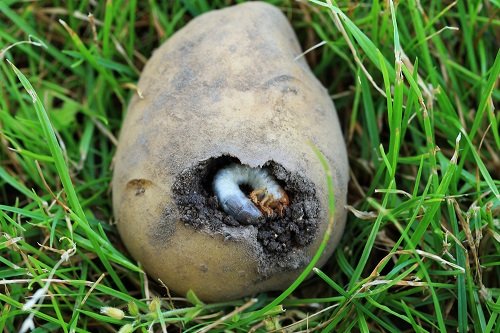

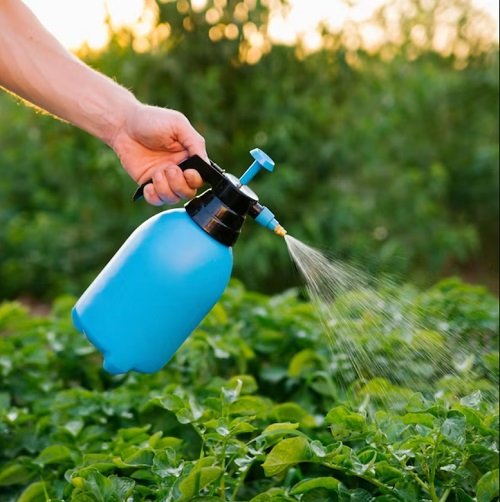



My mom does not have a garden, I studie Potato Bugs, and I am a kid so I
like Potato Bugs
Wanna Share Some Info On Potato bug When gardeners communicate approximately potato insects or tablet insects, they’re relating to two varieties of bugs particularly. These potato bugs are the Jerusalem cricket (Stenopelmatus fuscus) and the Colorado potato beetle .
I didn’t know predators were ancestors of potato bugs :O
Your article begins with Potato bugs (Jerusalem crickets), then morphs into discussing Colorado potato beetles. Please make up your mind and separate the two. You are attributing damage done by Colorado beetles to Potato bugs, and that is not true or fair.
Sort yourself out, please.